Whitefield Square (Savannah, Georgia)
 Whitefield Square and its gazebo | |||
| Namesake | Rev. George Whitefield | ||
|---|---|---|---|
| Maintained by | City of Savannah | ||
| Location | Savannah, Georgia, U.S. | ||
| Coordinates | 32°04′12″N 81°05′25″W / 32.0701°N 81.0904°WCoordinates: 32°04′12″N 81°05′25″W / 32.0701°N 81.0904°W | ||
| North | Habersham Street | ||
| East | East Wayne Street | ||
| South | Habersham Street | ||
| West | East Wayne Street | ||
| Construction | |||
| Completion | 1851 | ||
Whitefield Square is one of the 22 squares of Savannah, Georgia, United States. It is located in the fifth row of the city's five rows of squares, on Habersham Street and East Wayne Street, and was the final square laid out,[1] in 1851.[2] It is south of Troup Square and east of Calhoun Square in the southeastern corner of Savannah's grid of squares. The oldest building on the square is at 412–414 East Taylor Street, which dates to 1855.[3]
It is named for the Rev. George Whitefield (whose last name is pronounced Whitfield),[2] founder of Bethesda Home for Boys[4] (a residential education program – formerly the Bethesda Orphanage) in the 18th century, and still in existence on the south side of the city.
The square has a gazebo in its center.[2]
A notable building facing the western side of the square is the First Congregational Church.[2] Other prominent, though 20th-century buildings, are the Rose-of-Sharon Apartments (which occupies the entire northwestern tything block) and, across Habersham Street, the Red Cross Building.
The square was once a burial ground for African-American slaves. Due to this connection, a movement was started in 2021 to rename the square Jubilee Square, after Jubilee Freedom Day, the day when General William Sherman arrived in Savannah in 1864 to begin enforcing Abraham Lincoln's Emancipation Proclamation.[5]
Andrew Bryan, the founder of the First African Baptist Church, was buried in the square, as was Henry Cunningham, the minister of the Second African Baptist Church.[2]
Dedication[]
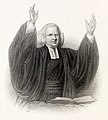
The square is named for Rev. George Whitefield, founder of Bethesda Home for Boys
Constituent buildings[]
Each building below is in one of the eight blocks around the square composed of four residential "tything" blocks and four civic ("trust") blocks, now known as the Oglethorpe Plan. They are listed with construction years where known.
- Northwestern civic/trust block
- First Congregational Church, 421 Habersham Street (1895)[6]
- Southwestern civic/trust block
- 431 Habersham Street (1886)[3]
- Mary Dwyer Property, 427–431 Habersham Street (1886)[3]
- Beth Eden Baptist Church, 302 East Gordon Street (1893)[7]
- Southwestern residential/tything block
- Northeastern residential/tything block
- 408 East Taylor Street (1891)[3]
- Andrew Nelson House, 410 East Taylor Street (1860)[3]
- George Ash Duplex, 412–414 East Taylor Street (1855)[3] – oldest building on the square
- 415A–D Price Street (1876)[3]
- Northeastern civic/tything block
- Southeastern civic/tything block
- Southeastern residential/tything block
Gallery[]
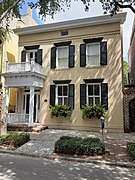
Andrew Nelson House, 410 East Taylor Street
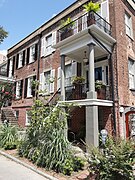
George Ash Duplex, 412–414 East Taylor Street

419 East Taylor Street
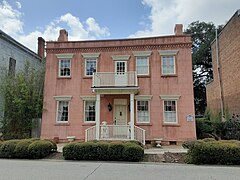
Henry Herman House, 313 East Gordon Street
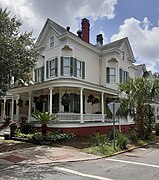
Sarah Sexton Property (1), 401 East Gordon Street
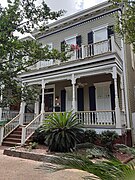
Sarah Sexton Property (2), 403 East Gordon Street

Emma Hunter House, 405 East Gordon Street
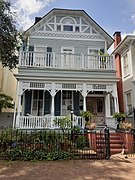
407 East Gordon Street
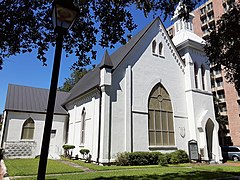
First Congregational Church, 421 Habersham Street
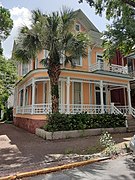
424 Habersham Street
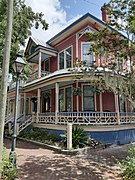
426 Habersham Street
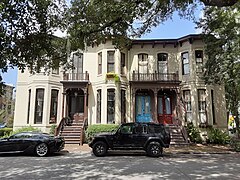
427–431 Habersham Street

430–432 Habersham Street

433 Habersham Street
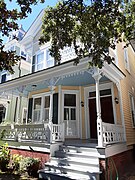
435 Habersham Street
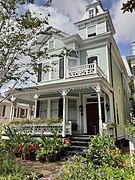
437 Habersham Street

433–437 Habersham Street, 1979

Sarah Sexton Property (3), 440 Habersham Street
References[]
- ^ Whitefield Square – City of Savannah website
- ^ a b c d e Whitefield Square – Savannah.com
- ^ a b c d e f g h i j k l m n o p q r s Historic Building Map: Savannah Historic District – Historic Preservation Department of the Chatham County-Savannah Metropolitan Planning Commission (November 17, 2011), p. 71
- ^ Bethesda Home for Boys
- ^ "Push to erase names of slaveholders from Savannah squares would be first change in a century" – Savannah Morning News, February 1, 2021
- ^ History – First UCC Savannah
- ^ Our History – Beth Eden Baptist Church
- ^ a b c d Historic Building Map: Savannah Historic District – Historic Preservation Department of the Chatham County-Savannah Metropolitan Planning Commission (November 17, 2011), p. 72
- Squares of Savannah, Georgia
- 1851 establishments in Georgia (U.S. state)
- Coastal Georgia geography stubs



















